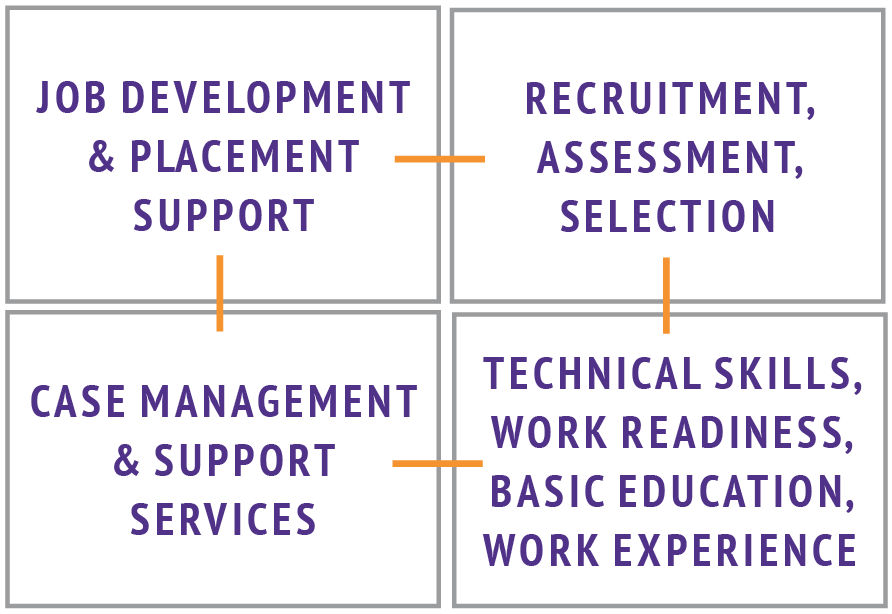Como Nancy presentó, esta es la tercera de cuatro publicaciones en nuestra serie de blogs Spring WCTF, Lograr resultados impactantes: observaciones de WCTF. En la publicación de hoy, el gerente del programa WCTF, Anthony Britt, explorará algunos elementos a menudo subestimados del diseño exitoso del programa.
Llegué a CommCorp desde la esfera de la educación pública, donde las lecciones más efectivas se planificaban con el objetivo final en mente. En
la última entrada del blogTheresa compartió cómo usamos los datos para informar nuestra toma de decisiones y maximizar la colocación de los participantes en empleos sostenibles, nuestro principal objetivo. Con la tasa de desempleo de Massachusetts en
3.6%, many businesses are having a tougher time finding qualified candidates for their open positions. How can sectoral employment programs help close this gap?
While the programs we fund take on different forms based on the needs of local businesses and job-seekers, we’ve seen a number of
elementos esenciales emergen como claves para el éxito, como la capacitación en habilidades técnicas informada por el empleador y los servicios de apoyo integrados. Al mismo tiempo, hemos visto que a menudo se subestiman algunos elementos del diseño del programa, como las estrategias de contratación y colocación.

Comenzando…
Given the significant amount of work that goes into planning training, the time and resources it takes to effectively recruit robust cohorts can be overlooked. There is value in starting your outreach early and making multiple points of contact with candidates as you may need to speak with four-plus people for each slot in the class.
Choosing partners strategically can expand your reach. In addition to working with One-Stop Career Centers, our programs have found it beneficial to partner with a diverse set of referral sources. Recently, one program in Western Massachusetts held a
evento bilingüe in partnership with a longstanding community-based organization who possessed Spanish-language proficiency in order to provide potential participants with exposure to hospitality and food preparation, the chosen occupational target. Other programs engage recruits through social media in addition to traditional flyers or by canvassing at natural gathering spots such as the local supermarket or DMV office.
Once a program has graduated a cohort or two, word-of-mouth from alumni can help spread awareness amongst their networks and even result in a level of familiarity amongst participants from day one.
…con el objetivo final en mente
Successful programs are able to identify the gap between businesses’ needs for skilled workers* and the current credentials and skill levels of their target participant population. They engage employers to identify the required technical skills and work readiness competencies as well as company-specific hiring requirements to increase the likelihood of placement beyond program completion.
When it comes to filling slots in a cohort, they implement processes that select participants who can benefit most from training, which requires a clear understanding of the factors most relevant to persistence in the training program AND to retention once hired. Factors such as:
- Niveles de alfabetización / aritmética
- Preparación para el trabajo / habilidades blandas
- Motivación e interés por trabajar en la ocupación objetivo
- Acceso al transporte
- Revisión CORI y prueba de drogas
One program in the Merrimack Valley held a half-day event with potential trainees to assess aptitude, desire, commitment, and readiness to succeed in transportation and construction careers. Over 20 prospective students attended this “try-out day” to fill one of eight positions in the class. Employer and training partners in attendance completed a survey that included collaboratively-defined metrics and were involved in making the final candidate selections.
Throughout this process, participants were able to demonstrate sufficient commitment and readiness for training and employment in a way that met both businesses and jobseekers where they were at. Experiences such as “try-out day” provide opportunities for jobseekers to learn more about the job and assess whether it is a good match for their own personal goals, work styles, aptitudes, and interests. Strategic selection and assessment policies also enable programs to match their support services to their participants’ needs. In fact, we are currently trying out some of these ideas and more with our most recent round of
beneficiarios de WCTF.
Well-executed sectoral employment programs bridge businesses’ needs for skilled workers and residents’ needs for good-paying jobs. We know that early and on-going collaboration with employers is fundamental. Also, by gaining a deep understanding of the individuals served, programs can anticipate gaps and build appropriate supports into their program design. This requires working in and across business, education, government, and community cultures. Stay tuned for Rebekah’s upcoming post about developing sector partnerships!
*Esperamos verte en el Conferencia de CWC el 11 de mayoth donde Theresa y Rebekah presentarán el importante primer paso de identificar qué problema del mercado laboral está tratando de resolver a través de su programa de empleo sectorial impulsado por la demanda.
Escrito por Anthony Britt, Gerente de Programa del Fondo Fiduciario para la Competitividad de la Fuerza Laboral. Anthony se unió a CommCorp en julio de 2016 y está comprometido a mejorar los resultados de las personas marginadas a través de un mayor acceso a oportunidades económicas y educativas de calidad y una reforma sistémica.

